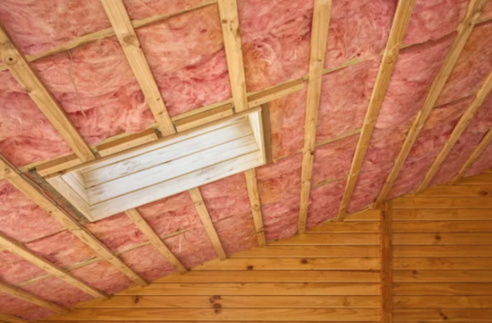What is batt insulation?Batt insulation is one the most common types of insulation used in the insulation industry. Batt is mostly used between the framing of a house. Other uses for batt are attic insulation, wall, floor and ceiling insulation.
Batt insulation comes in a variety of R-values and comes pre-cut in the form of cut rock or fibreglass in different sizes. The different sizes make it easier to fit into smaller vehicles. It is also fairly easy to install by a pro and takes the least amount of time compared to other types of insulation. Batt is the easiest and cheapest way to insulate a home or business, but if not installed properly it loses a good chunk of its insulation properties, up to (25%). Batt should always be fitted tight and neat so there are no empty spaces or gaps around it. |
Batt insulation is usually made from fibreglass fibres and sometimes made from mineral wool also known as rock wool which is made from a combination of synthetic and natural fibres like cotton and sheep’s wool.
Batt insulation is used in a number of areas such as attics, ceilings, walls and floors. It is also good for wall studs, floor joists and attic rafters. Batt also requires a vapour barrier, it can be achieved by adding layers of blown-in cellulose on the top. Batt insulation is fairly easy and quick to install and can save you up to 50% of energy required to cool or heat a home and has great noise reduction qualities along with a satisfactory vapour resistance.
Fibreglass comes in a number of different sizes and types, mineral wool is pressed into place and comes in the form of un-faced batts.
Batt insulation is available in variety of R-Values and is the most cost efficient way to insulate a home or business. It does not settle and maintains its insulation properties over time.
Batt insulation is used in a number of areas such as attics, ceilings, walls and floors. It is also good for wall studs, floor joists and attic rafters. Batt also requires a vapour barrier, it can be achieved by adding layers of blown-in cellulose on the top. Batt insulation is fairly easy and quick to install and can save you up to 50% of energy required to cool or heat a home and has great noise reduction qualities along with a satisfactory vapour resistance.
Fibreglass comes in a number of different sizes and types, mineral wool is pressed into place and comes in the form of un-faced batts.
Batt insulation is available in variety of R-Values and is the most cost efficient way to insulate a home or business. It does not settle and maintains its insulation properties over time.
What is the R-Value of Batt insulation?
R-Values (Resistance Value) is a measurement system of how the insulation performs. The higher the R-Value the more insulating properties and thermal resistance.
Things to consider when measuring R-Values are the thickness and type of insulation used. For example wool insulation has a better R-value than fibreglass. Proper installation also plays a role in maximum efficiency.
Resistance Value:
Insulation Type: R-Value per Inch:
Fiberglass (batts). 2.9 – 3.8
Stone Wool (batts) 3.3 – 4.2
Cotton (batts). 3.0 – 3.7
R-Values (Resistance Value) is a measurement system of how the insulation performs. The higher the R-Value the more insulating properties and thermal resistance.
Things to consider when measuring R-Values are the thickness and type of insulation used. For example wool insulation has a better R-value than fibreglass. Proper installation also plays a role in maximum efficiency.
Resistance Value:
Insulation Type: R-Value per Inch:
Fiberglass (batts). 2.9 – 3.8
Stone Wool (batts) 3.3 – 4.2
Cotton (batts). 3.0 – 3.7





